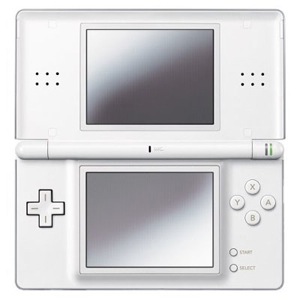 The Nintendo DS was the first game system that I followed from
announcement to launch. It was way back early 2004 that Nintendo first
hinted at a dual-screened handheld, then codenamed "Nitro." Considering
that was the only information available, it's not surprising that many
questioned Nintendo's strategy. Why two screens? Nintendo offered some
hypothetical benefits, like extra camera angles for sports games, but
their words were hardly convincing. Little did we know, it was
Nintendo's first step into the "blue ocean" strategy that would lead the
company to greener pastures.
The Nintendo DS was the first game system that I followed from
announcement to launch. It was way back early 2004 that Nintendo first
hinted at a dual-screened handheld, then codenamed "Nitro." Considering
that was the only information available, it's not surprising that many
questioned Nintendo's strategy. Why two screens? Nintendo offered some
hypothetical benefits, like extra camera angles for sports games, but
their words were hardly convincing. Little did we know, it was
Nintendo's first step into the "blue ocean" strategy that would lead the
company to greener pastures.
And yet, the original DS launch in November 2004 came and went with
little fanfare. I was aware of the date, but didn't even realized that
it arrived until I walked through a Wal-Mart electronics section and saw
the grey handheld on the shelves. I kept walking. I was
Nintendo faithful, sure, but it was hard to get excited about a launch lineup headlined by something nearly a decade old. It wasn't until the impending release of Kirby Canvas Curse in the
summer of 2005 that I decided to bite the bullet, trading in half of my
Gamecube library to GameStop in order to pay off the Nintendo DS and one
game.
While it's certainly worth praise in its own right, I think Canvas
Curse deserves to be remembered as the flagship of the DS library; it
was the first of a fleet of incredible games that would follow in its
wake. A system redesign, dubbed the DS Lite, accompanied the platform's
newfound software vigor. Reduced size, brighter screens, and an iPod
aesthetic provided enough worth for many to upgrade (including me) and
many more to buy in for the first time. The sleeker profile and beefier
games are what truly began the success story of the best-selling handheld game
system ever.
But even Nintendo's first detour in the generations-old graphical arms
race would lead to a dead end eventually. With the launch of a
successor, the 3DS, history tells us that the best we can hope for is a
year or two of life support for what was once Nintendo's "third pillar." It was an
incredible performance that none could have predicted, and I think the
Nintendo DS deserves a hearty round of applause before its curtain call.
I've decided to contribute to the celebration in that age-old tradition
of blogging: the top ten list.
In no particular order, here are ten great games that exemplified some aspect of the Nintendo DS' legacy.
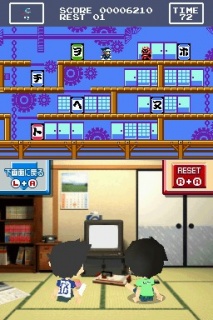 Retro Game Challenge
Retro Game Challenge
The DS is a two-faced system: it has the freedom to innovate but retains
a certain old-school legacy in its graphical abilities and button
layout. And it doesn't get much more old-school than Retro Game
Challenge, a collection of NES-era games that never actually existed.
The metagame of RGC puts you in the role of...well, your 8 year old
self. You are challenged by a friend to reach certain landmarks in each
of the familiar (yet fictional) classics in order to unlock the rest.
The charm of the setup will thrill anyone who grew up in the days of the NES or Famicom,
as it includes so many peripheral aspects of the time's gaming culture.
From the bizarre magazines with cheat codes and interviews to
living room high-fives in front of the tube, RGC deftly tugs at the
nostalgia strings. Each game in the collection is clearly inspired by at
least one classic from the mid-to-late eighties, yet some modern
accoutrements and twenty years of design progress are weaved into the
package to make some of the titles even better than those that inspired
them. Retro Game Challenge is a
must-have for anyone who longs for a brief return to gaming culture in
the early NES era.
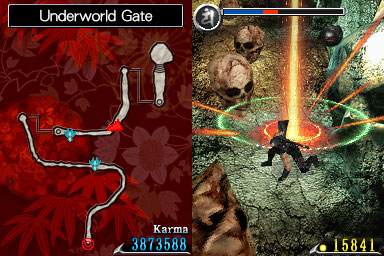 Ninja Gaiden Dragon Sword
Ninja Gaiden Dragon Sword
Team Ninja's only portable credit is my favorite example of a console
series translated to the DS touch-screen. Holding the DS sideways, like a
book, the player controls all of Ryu's ninja moves with pokes and
swipes of the stylus (though blocking is handled by a shoulder
button). The overwhelming variety of combos available in the Xbox game
may have been pared down to the bare essentials, but Dragon Sword
certainly doesn't suffer for its simplicity: the series' lightning-quick
combat and brutal difficulty are intact, and the visuals are an
impressive achievement for the DS' limited power. Ninja Gaiden DS proved
the little dual-screen system's might as a legitimate outlet for 3D
action games.
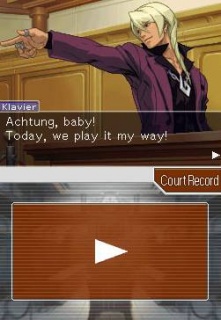 Apollo Justice: Ace Attorney
Apollo Justice: Ace Attorney
Who could have known that "OBJECTION!" would become video
game lingo? Originally a Game Boy Advance series in Japan,
the Phoenix Wright: Ace Attorney trilogy was ported to the DS
from 2005 and exported worldwide. It was also the first of several DS hits in the
visual novel genre, a style of game previously rare outside of Japan and reminiscent of the point-and-click adventure games so fondly remembered.
Apollo Justice: Ace Attorney was the first game in the
series exclusively developed for the DS, and it occasionally makes
specific use of the touch-screen and microphone elements in ways its
predecessors don't. It serves as a paradigm shift away from the
familiar characters of the previous trilogy, ensuring it succeeds as a
standalone game, and I think it carries the strongest humor in the
series as well. Throughout its life, the Nintendo DS provided
opportunity for niche games to shine, and it's the reason why the Ace
Attorney series is now a worldwide hit.
 Rhythm Heaven
Rhythm Heaven
The WarioWare series introduced gamers to the joy of rapid-fire nonsense, and Rhythm Heaven set that concept to a musical beat. Holding the DS "book-style" a la Ninja Gaiden DS, players poke, hold, and flick the stylus in order to make joyous music through charming minigames. The appeal of music is universal, and Nintendo hoped the DS' audience would be just as broad: they even went as far as including Beyonce in Rhythm Heaven's marketing blitz. Contrary to today's intimidating music games, Rhythm Heaven can be played by anyone, and Nintendo used a mainstream star to get the word out about this quirky little package.
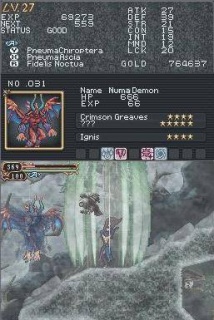 Castlevania: Order of Ecclesia
Castlevania: Order of Ecclesia
When Nintendo first let the two-screened cat out of the bag, I was one of the many who doubted the practical use of a second display. Perhaps it was Nintendo's first statements about "extra camera angles" that threw me off, but every possible use I could think of was convoluted at best. One of the first games to really sell me on the idea was Castlevania: Dawn of Sorrow, which uses the top screen as either a castle map or a stat sheet.
In theory, neither function sounds especially beneficial, but now I realize just how convenient these features are when I replay one of the earlier Metroidvania games with just one screen. Traversing the sprawling, interweaving demon palace is just so much quicker with a map handy at all times. And the stat display provides an excellent on-the-fly bestiary, complete with drop rates and elemental effects. While Dawn of Sorrow's touch-screen gimmicks were no longer in the picture for Portrait of Ruin, the map and stat screen would persist all the way through Order of Ecclesia, which quickly became my favorite game in the franchise. Brutally difficult and incredibly customizable, OOE continues the strong portable Castlevania tradition and tweaks a few mechanical subtleties to provide a strong finale for the DS Castlevania siblings.
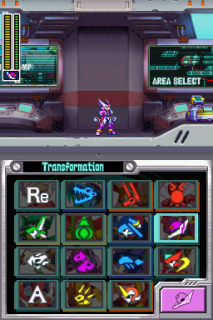 Mega Man ZX Advent
Mega Man ZX Advent
Konami's portable Castlevania team proved that even a minor feature on the second screen could drastically improve an otherwise unchanged game. Inti Creates, Capcom's Mega Man action-platformer team for the last decade, was one of many that didn't fare so well. For every classic game that found an appropriate use for the second screen, there was a dozen that shoehorned in some half-hearted quirk solely for another bullet point on the back of the box.
Mega Man ZX actually created a separate use of the touch-screen for each of the handful of transformations available in the game. One provided a treasure-highlighting map. Another allowed radar nightvision. The most interesting let the player change the trajectory of their buster shots. It's difficult to argue that any of them improved the core game in any meaningful way, but they didn't need to: Mega Man ZX was a solid action game on its own. The sequel, Mega Man ZX Advent, didn't bother tweaking the touch-screen functions at all, but it did make a number of improvements from its predecessor, including a worthwhile map and doubling the stock of transformations. While the two Mega Man ZX games could have just as easily been done on any other system, they certainly didn't suffer as DS cards.
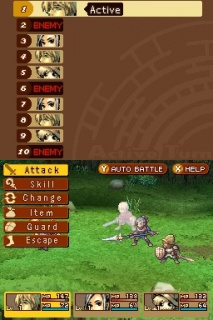 Radiant Historia
Radiant Historia
Options are good. I'm always disappointed when I find that a game's control scheme is locked in whatever setup the developer thought best. The DS' touch screen caused many developers to reconsider how one should control certain games, but sometimes the old D-pad and buttons are the best way to go. This is how I started playing Radiant Historia, with left thumb commanding movement and right thumb confirming actions. Yet, when I handed the system off to a friend to check the game out, he instinctively pulled out the stylus and began poking the touch-screen. Before I could tell him he was doing it wrong, I was surprised to see that it worked perfectly: I hadn't even realized that the entire game could be played with the touch-screen alone, and in some aspects it actually made more sense. It didn't even occur to me to try, but that's right where others will start.
No matter which way you prefer to play, I can't recommend Radiant Historia enough. Boasting a clever battle system, excellent pacing, balanced challenge, and eloquent dialogue, it deserves to be mentioned among the very best RPGs on the Nintendo DS, even among the dozens of instant classics and remakes of fan favorites that the system saw through its life.
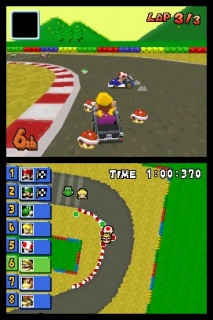 Mario Kart DS
Mario Kart DS
One of the great things about handheld gaming is that every player has his or her own screen (or two). Prior to the DS, portable systems all had to be connected through a series of proprietary physical links, making the process cumbersome and prone to failure. The DS' ad-hoc local wireless capabilities made multiplayer portable gaming easier than ever, and my pals and I first realized how wonderful it could be with our eight player Mario Kart DS marathons. Eight friends scattered around the living room, competing in the same game, each with their own system...to this day, these are my favorite multiplayer gaming memories.
Mario Kart has always been Nintendo's showcase for multiplayer each generation, and Mario Kart DS upped the ante as Nintendo's first game to ever feature online play. While the Nintendo Wi-Fi Connection suite was meager when compared to the local multiplayer smorgasbord (or by any standards, really), it was Nintendo's first awkward baby step into the world of online play. And despite its myriad of limitations and the eventual whittling of the online community down to its very best exploitists, Mario Kart DS online was pretty fun for a while. The ease of multiplayer, the invaluable map on the second screen, and some wonderful track designs made Mario Kart DS my favorite in the series.
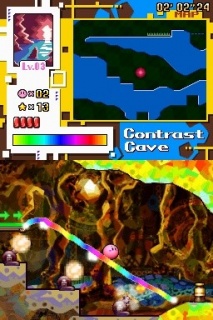 Kirby Canvas Curse
Kirby Canvas Curse
It's strange: Kirby tends to be the harbinger of death for a Nintendo console. Kirby's Adventure was one of the last great games for the NES. Kirby Super Star was barely out the door when the Nintendo 64 hit shelves. And Kirby 64 was one of the few worthwhile titles of the N64's lean final years. But Kirby's pocket-sized efforts have always been strong players on Nintendo's portables, and perhaps none were more important than Kirby Canvas Curse. One of the versatile pink puff's many creative spinoffs, the brilliant touch-screen controls and vibrant 2D visuals are what made Canvas Curse the game for early adopters to show off. I can say this from experience: Canvas Curse is what sold enough of my friends on the DS to make those eight player Mario Kart DS gatherings possible.
One DS launch failing was developers' insistence on milking the system's processing power, which was in the Nintendo 64's neighborhood at best. Many players' first impressions were crude polygonal copycats of the same old console games. Kirby Canvas Curse found the system's strength -- creative use of the touch-screen -- and built around that instead. Much like the Nintendo DS itself, Kirby Canvas Curse will be remembered not as a technological achievement, but as a brave experiment that turned out to be something special.
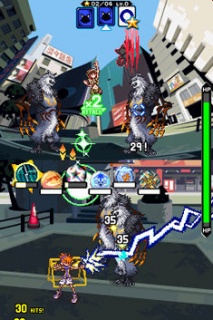 The World Ends With You
The World Ends With You
In his own excellent departing salute to the Nintendo DS, Jeremy Parish claimed that no game embodied all that was the Nintendo DS better than The World Ends With You. I couldn't agree more.
TWEWY isn't perfect. It gets off to a pretty slow start. Many were baffled by how it worked and what it offered when they caught their first glimpse of it. And in a lot of ways, it seems to buck convention merely for the sake of being different.
But once you acclimate to it, you begin to see some hidden genius. The refusal to abide by tried-and-true methods leads to far more joy than frustration. It provides options and frameworks that you just don't expect. At some point, the initial confusion and disappointment makes way for something that just clicks, feeling so fresh and engaging. In the end, you learn a little something about keeping an open mind and expanding the limits of your world.
I initially dismissed TWEWY and the Nintendo DS as botched experiments with little potential. I won't make that mistake again.
We're a week away from the 3DS launch. In a lot of ways, it's eerily familiar: an unproven hardware gimmick, a lackluster launch lineup, and rumblings of a far prettier, more fully-featured competitor on the horizon. Though I'll play several launch games next week, I don't actually plan on purchasing any of the launch titles myself. That said, I've had my 3DS system reserved for three months now. It might not hit the ground running, but I have faith that the 3DS will find its stride soon enough, just like its predecessor. And until it does, there are plenty of DS games I can catch up on in the meantime.
 The Nintendo DS was the first game system that I followed from
announcement to launch. It was way back early 2004 that Nintendo first
hinted at a dual-screened handheld, then codenamed "Nitro." Considering
that was the only information available, it's not surprising that many
questioned Nintendo's strategy. Why two screens? Nintendo offered some
hypothetical benefits, like extra camera angles for sports games, but
their words were hardly convincing. Little did we know, it was
Nintendo's first step into the "blue ocean" strategy that would lead the
company to greener pastures.
The Nintendo DS was the first game system that I followed from
announcement to launch. It was way back early 2004 that Nintendo first
hinted at a dual-screened handheld, then codenamed "Nitro." Considering
that was the only information available, it's not surprising that many
questioned Nintendo's strategy. Why two screens? Nintendo offered some
hypothetical benefits, like extra camera angles for sports games, but
their words were hardly convincing. Little did we know, it was
Nintendo's first step into the "blue ocean" strategy that would lead the
company to greener pastures.










